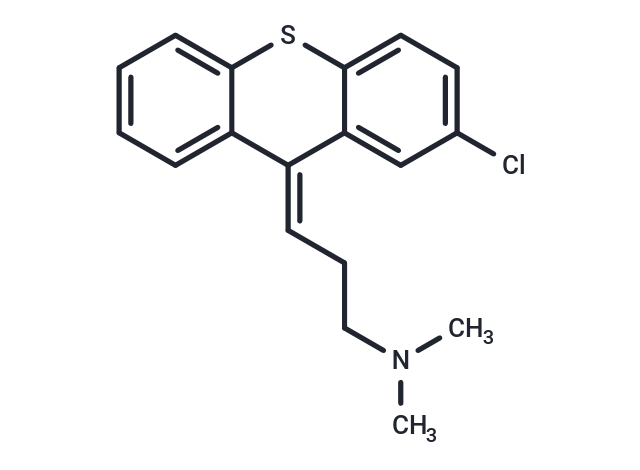Shopping Cart
Remove All Your shopping cart is currently empty
Your shopping cart is currently empty
Chlorprothixene (Truxal) is a typical antipsychotic drug of the thioxanthene class, which was the first of the series to be synthesized.

| Pack Size | Price | USA Warehouse | Global Warehouse | Quantity |
|---|---|---|---|---|
| 100 mg | $31 | In Stock | In Stock | |
| 200 mg | $48 | In Stock | In Stock | |
| 500 mg | $98 | In Stock | In Stock | |
| 1 g | $143 | - | In Stock |
| Description | Chlorprothixene (Truxal) is a typical antipsychotic drug of the thioxanthene class, which was the first of the series to be synthesized. |
| Targets&IC50 | 5-HT7:5.6 nM(Ki), D1 receptor (human):18 nM (Ki), D3 receptor:4.56 nM(Ki), 5-HT6:3 nM(Ki), D2 receptor:2.96 nM(Ki), H1 receptor:3.75 nM(Ki), D5 receptor (human):9 nM (Ki) |
| In vitro | When Chlorprothixene acts on the brain, it inhibits the postsynaptic mesolimbic dopamine D1 and D2 receptors, reducing the release of hypothalamic and pituitary hormones. In mouse brains, Chlorprothixene reduces levels of 5HT, NE, and DA. At high doses, Chlorprothixene's effect on adrenal medulla and brain tissue can inhibit the action of nicotinic acid isopropylhydrazine, inducing the release of catecholamines for protective purposes. Additionally, Chlorprothixene has an inhibitory effect on acidic sphingomyelin in murine bronchial epithelial cells, promoting the repair of neuronal myelin concentration, thereby decreasing the incidence of inflammatory responses in mice with cystic fibrosis and also preventing infection by Pseudomonas aeruginosa. |
| In vivo | Chlorprothixene induces Vero 76 cells, resulting in inhibited replication of SARS-CoV. It exhibits high affinity for the murine 5-HT6 receptor in stably transfected HEK-293 cells, with a Ki value of 3 nM, and for the transiently expressed murine 5-HT7 receptor in COS-7 cells, with a Ki value of 5.6 nM. Chlorprothixene has a strong binding affinity to histamine and dopamine receptors including D1, D2, D3, D5, and H1, with Ki values of 18 nM, 2.96 nM, 4.56 nM, 9 nM, and 3.75 nM, respectively. However, its affinity for the H3 receptor is weak, with a Ki value greater than 1000 nM. |
| Synonyms | Truxal, Taractan, Clorprotixeno |
| Molecular Weight | 315.86 |
| Formula | C18H18ClNS |
| Cas No. | 113-59-7 |
| Smiles | C(\CCN(C)C)=C/1\C=2C(SC=3C1=CC=CC3)=CC=C(Cl)C2 |
| Relative Density. | 1.1048 g/cm3 (Estimated) |
| Color | Yellow |
| Appearance | Solid |
| Storage | Powder: -20°C for 3 years | In solvent: -80°C for 1 year | Shipping with blue ice/Shipping at ambient temperature. | |||||||||||||||||||||||||||||||||||
| Solubility Information | H2O: < 1 mg/mL (insoluble or slightly soluble) DMSO: 10 mg/mL (31.66 mM), Sonication is recommended. Ethanol: 27 mg/mL (85.48 mM), Sonication is recommended. | |||||||||||||||||||||||||||||||||||
| In Vivo Formulation | 10% DMSO+40% PEG300+5% Tween 80+45% Saline: 1 mg/mL (3.17 mM), Sonication is recommended. Please add the solvents sequentially, clarifying the solution as much as possible before adding the next one. Dissolve by heating and/or sonication if necessary. Working solution is recommended to be prepared and used immediately. The formulation provided above is for reference purposes only. In vivo formulations may vary and should be modified based on specific experimental conditions. | |||||||||||||||||||||||||||||||||||
Solution Preparation Table | ||||||||||||||||||||||||||||||||||||
DMSO/Ethanol
Ethanol
| ||||||||||||||||||||||||||||||||||||
| Size | Quantity | Unit Price | Amount | Operation |
|---|

Copyright © 2015-2025 TargetMol Chemicals Inc. All Rights Reserved.